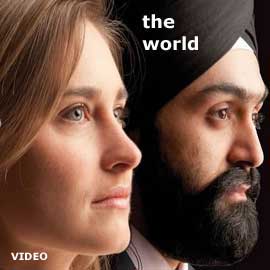Sports
The Cricket Warrior:
Kenya’s Jasmer Singh
CYPRIAN FERNANDES
Kenya said kwaheri to Bwana Cricket last Friday. The doyen of Kenyan cricket, Sardar Jasmer Singh was 85 when he took his final bow on Wednesday, September 21, 2016.
I met Jasmer Singh around 1960 during an Asians vs Europeans match at the Nairobi Sports Club. I had just joined the “Daily Nation” and was covering the match as my first assignment.
As I went around introducing myself to a group, I stretched my hand to greet Jasmer (many months later he told me his friends called him Melee). He did not say anything but appeared to be suppressing a growl.
He was there to cover the match for the “East African Standard.”
It was not long before the growl changed to a smile and he was answering the million questions I had about cricket and the match. Melee was my first journalistic cricket teacher.
I was never to forget that growl because I would hear it often as he stood his ground against a foe in a debate. It was usually about sports and mostly sport politics. Melee rarely gave an inch. After all, he was a Sikh and history records Sikhs as warriors.
He fought battles for the good of cricketers and the game, hockey and hockey players and especially, about Sikhs, Sikhism and Sikhs in sport.
Melee attended two sanctuaries: The Gurdwara and the Sikh Union Club on Forest Road. Friends would tease him that he was at the clubhouse eight days a week and never missed an occasion, a match or club meeting.
He played top grade cricket along with some hockey for most of his “young life”. He was, in fact, a serial sportsman, but there was always time for family, work, friends and journalism.
Melee left the civil service in 1968 to set up South Africa-based Drum Publications in Nairobi. By the time he left in 1992, circulation of Drum had shot up to 120,000 from 12,000.
A MILESTONE
It was in 1963 that MJK Smith, the England cricket captain, brought an MCC side to Nairobi. As we sat watching, Melee turned to me and said: “We can do this, you know.”
“Do what?” I asked.
“Become a test cricket nation,” he replied with a little growl.
“With four Sikhs, two Goans, two Patels and a Muslim?” I asked cheekily. After all, it was 1963 and murmurs of an Asian exodus had begun.
“There will always be Asians in Kenya. And can you imagine how strong the team will be if it has trained indigenous Kenyans?”
I agreed with him that if Africans took up the sport, it would bring a new dimension to the game in Kenya. Hadn’t the West Indies shown what great cricket black players could play?
“When will you start?” I asked.
“Soon,” he said. “But don’t tell anyone I said so.”
Not many people saw that vision. I doubt if there was a happier person in the world when Kenya began playing in cricket’s greatest arenas and even beat the West Indies in India in 1996 with Melee as team manager.
However, it was in 2003 in South Africa when Kenya stunned the world by becoming the first and only associate nation to reach the semi-finals of the Cricket World Cup, beating test nations Zimbabwe, Bangladesh and Sri Lanka in the process.
There were hundreds of awards but two stick out: Life membership of Marylebone Cricket Club and International Cricket Council’s Lifetime Recognition award for services as a player and administrator.
He must have reserved his greatest pride when Kenyan players became household names. Some of these include Thomas Odoyo, Steve Tikolo, Kennedy Otieno and David Obuya.
GREAT MEMORY
In the end, Melee died of a broken heart after Kenya’s cricket deteriorated. Former ‘Daily Nation’ sports editor Norman Da Costa writes:
“My first encounter with Jasmer Singh was in 1963 when, in my final year at Dr Ribeiro’s Goan School, my name was forwarded to the Kenya Cricket Association to train with MCC coach Willie Watson for a possible spot in the Kenya schools team.
“I didn’t make it but I won’t forget Jasmer because that day at the Sikh Union was the start of a long and sometimes rocky friendship that lasted until 1976 when I left for Toronto.
“I admired what he accomplished. He was the field hockey writer for the ‘East African Standard’ when only a select few of our people were given an opportunity to write for the paper.
“He then got himself on the ‘Voice of Kenya’ as a fill-in for a sports talk show on Sunday morning.
“We may have had our differences in hockey involving Goans and Sikhs but I respected him. We always had a few jugs of beer and I will raise one for my friend. Rest in peace, Melee.”
[Courtesy: Daily Nation. Edited for sikhchic.com]
September 28, 2016
Conversation about this article
1: Visho Sharma (Kalamazoo, Michigan, USA), September 29, 2016, 9:22 PM.
Meli was a personal friend since our shared childhood on Park Road. Let me give an example of Meli's concern. Our generation held Karamchand in awe, and Meli did a lot for him after the legend's severe stroke. The opener laid the ground, if you will, for the greatest One-down in Kenyan cricket. Please, read a volume into that snippet.
2: Bhupinder Singh Mahal (Dundas, Ontario, Canada), October 01, 2016, 10:56 AM.
In the fall of 1953, just before leaving Kenya, I was a journeyman reporter for the 'Daily Chronicle' under the tutelage of the renowned D.K. Sharda. At the time Meli worked for the Public Works Department. I saw Meli as an elder brother. Most mornings our paths crossed at the Desai Road and Ngara Road roundabout on our way to work. I usually took the bus except when I ran into Meli and then I would tag along with him. I loved listening to his humorous anecdotes about the goings-on at the Sikh Union. But mostly he stressed higher learning and personal growth, a mentor when the term was not in vogue. Mzee Meli lit a candle that will remain lit.



